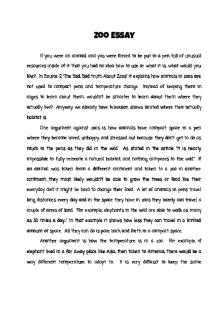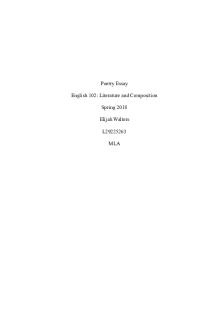SO4032- Essay on Race - Grade: B PDF

| Title | SO4032- Essay on Race - Grade: B |
|---|---|
| Course | Introduction to Sociology 2 |
| Institution | University of Limerick |
| Pages | 6 |
| File Size | 104.2 KB |
| File Type | |
| Total Downloads | 4 |
| Total Views | 123 |
Summary
Essay on Race ...
Description
SO4032- Introduction to Sociology 2 Essay: Race Introduction: This paper will argue that “race” is socially-constructed and discuss how and why this is so, providing a sociological perspective as an alternative to the socially constructed dictionary definition of race. In this paper I shall be incorporating racialisation in order to further my case, and to reinforce my opinions on the concept of “race”. I shall discuss racism and its many forms along with the negative impacts it has on certain members of society who fall into a certain “race”. ‘Race’ from a sociological perspective: A sociological perspective on racism involves us having to break down any preconceived notions on what “race” means in particular the “socially constructed views” (Punch et al. 2013) that we find in our dictionaries, that add little to no depth on what “race” really means. In order to better understand what “race” means from a sociological perspective, we must view it i the eyes of the many great sociologists that have gone before us and their definitions of “race” . In order for a better explanation of such I shall use several examples of sociological definitions offered by these sociologists throughout my paper. Starting with Robert Miles. Robert Miles for example defined “race” as : “The holding of derogatory social attitudes of cognitive beliefs towards members of a particular group on account of their membership to that group” (Punch et al. 2013) This definition can be very unreflective, and I believe that when Miles was referring to a “particular group”, those particular groups or “races” and what constitutes a race were better explained by the sociologist Arthur Atkins, who outlines six qualities of what constitutes a “race” : Atkins believed that race is “marked by certain somatic markers and bodily differences” (Atkin 2014) such as “skin colour, facial features” and “hair texture”. I should also highlight before I continue that the “American Association of Anthropologists, the American Sociological Association, and the American Psychological Association have all taken an official position rejecting the biological explanations of race.” (OpenStax 2015) and Atkins approach is almost entirely based on biology, so this comes to question if in fact “race” is even real. Atkin also described race as “something we inherit” (Atkin 2014), and alot of Atkins key concepts can be agreed with, as many of us do share similar features with our parents and predecessors. Atkins third key
concept on race is that “racial differences are tied to geographical origins”. This too can still be seen in modern day society, as the various countries all over the world are inhabited by people who all look slightly different. These differences however, geographically, can be seen to of been caused by the varying climates, and the effects that these climates have on bodily appearances, for example in countries around the equator where the sun is considerably more prolific, the extra rays cause the melatonin in the skin of these countries to darken. Atkins also focused on how “different races have different physical and mental capabilities” (Atkins 2014), this takes me back to my point once again about inheritance and geographical locations, as through the centuries certain races will become more accustomed to certain activities, and develop certain abilities over time in certain areas due to their constant exposure to such activities, and the influence of their predecessors. Atkins defines “races” as having “different cultural and attitudinal behaviours”(Atkins 2014), this being one of the most perverse notions put forward by Atkins, as it can be easily misunderstood, and used to target specific races by tying negative attributes to them. However, on the reverse, this concept allows those distinguished as part of a certain race, to create their own racial identity. Which in a sense can provide a race with a sense of pride and ownership over who they are and the sub-group within society which they belong to. This takes me on to my next point proposed by Atkins that “Races are more or less pure”. Races will all possess the above characteristics which I have outlined, however as different races breed together, and reproduce, many theorists have speculated on the degree of which these children will inherit the qualities of their parents when from different racial bloodlines. The agreed conclusion however, is that since “races” are more or less pure, many of the characteristics from both sides will be inherited. Thus resulting in the “maintenance of racial purity” (Atkins 2014) Racial purity in turn leads us on to racialisation.
Racialisation as a process: Racialisation is a process by which we create our ‘in-group’, and how we categorise subcultures due to their ‘race’ into tiers in society. Racialisation “ ascribes physical and cultural differences to individuals and groups” (Barot and Bird 2001) in order to categorise these races. Racialisation is used to justify discriminatory behaviour in society and to “justify or explain social stratification, inclusion or exclusion.” (Carr & Haynes 2015) Racialisation has become embedded within society, for example in every census issued by a country, citizens are asked to identify to their particular race or ethnic group. Which furthers my point
upon social hierarchies formed by our governments, for reasons unexplained to us as to why the distribution of races amongst society would make any difference to policy making. Racialisation has been described as being “the establishment of social hierarchies based on supposed biological inequalities” (Nehring 2013). This in turn leads me on to discuss the next part of my essay; racism.
Racism: Racism is the “belief that such hierarchies of race are factually accurate” (Nehring 2013) However Miles & Browne argue that ‘racism is ... a representational form which, by designating human collectivities ... functions as an ideology of inclusion and exclusion.’ (Miles & Browne 2006). Racism is and has been utilised by the elites within society for centuries, and is associated with those who held power throughout the centuries, to seclude & exclude minorities, or people who did not satisfy a certain ideal image or satisfy the agendas of political leaders. Racism can be seen from a functionalist perspective as granting the majority race power over the minority race justifying racial inequality. Racism has perforated our society for decades and the continued success & existence of racism can be thankful to the ability of racist ideologies to “to employ/deploy various ‘logics’ over time and space” (Lentin, 2008: 10). Zygmunt Bauman perfectly illustrated the effects of racism in his study of Modernity and the Holocaust. Racism can ruin the lives of all of those targeted, Bauman uses the Holocaust to show just how extreme some of the consequences of racism are. From my interpretation, I found that racism can challenge a person's “citizenship”, reduces “legal equality” and even after being removed from segregation facilities, people who are exposed to racism will always feel segregated and separated in some way, shape or form. This is a perfect example of Dollard’s scapegoat theory and institutional racism in which Germany’s socio-economic problems were blamed on the Jewish people, purely due to race, thus racism is a way of scapegoating “races” within society.
Conclusion: I shall conclude by summarising the key aspects of this essay which I have discussed. I have discussed the various definitions available from a sociological perspective on “race” and what “race” really means. Following on from this, I expanded by definition by discussion racialisation, and the process and function in which it plays. This in turn lead to my
discussion on racism, and my arguments for the negative impacts that racism has, based on my interpretation of evidence proposed by Zygmunt Bauman. I did not speculate on my opinion on racism regimes, and at the end of my essay, I have given the reader the opportunity to form their own opinions on racism, by simply stating the detrimental effects it has had on society as a whole throughout the ages, and its presence in modern day, that has been obscured and hidden within political regimes.
Reference List: Atkin, A. (2014) The Philosophy of Race, London and New York: Routledge, chapters 1 & 2
Barot, R. and Bird, J., (2001). Racialization: the genealogy and critique of a concept. Ethnic and racial Studies, 24(4), pp.601-618.
Bauman Z (1989) Modernity & the Holocaust, Cambridge: Polity Press, pp 12-18 & 56-60 Carr, J. and Haynes A., (2015) ‘A clash of racializations: The policing of ‘race’ and of antiMuslim racism in Ireland. ‘Critical Sociology, 41(1), pp.21-40
Miles, R. and Browne, M. (2006) Racism, London: Taylor and Francis.
Nehring, D (2013) Sociology: An Introductory Textbook & Reader, Harlow: Pearson Education pp.394-405
OpenStax (2015) Introduction to Sociology, Houston: OpenStax, Rice University, pp.226-234
Bibliography :
Atkin, A. (2014) The Philosophy of Race, London and New York: Routledge, chapters 1 & 2
Barot, R. and Bird, J., 2001. Racialization: the genealogy and critique of a concept. Ethnic and racial Studies, 24(4), pp.601-618.
Bauman Z (1989) Modernity & the Holocaust, Cambridge: Polity Press, pp 12-18 & 56-60
Carr, J. and Haynes A., (2015) ‘A clash of racializations: The policing of ‘race’ and of antiMuslim racism in Ireland. ‘Critical Sociology, 41(1), pp.21-40
Garner, S. (2009) ‘Ireland: From Racism without ‘Race’ to Racism without Racists;’ Radical History Review, Issue 104, pp. 41-56. Macionis J. and Plummer, K. (2012) Sociology: A Global Introduction, 5th ed. Harlow: Pearson Education/Prentice Hall Europe, pp. 346-378.
Miles, R. and Browne, M. (2006) Racism, London: Taylor and Francis.
Nehring, D (2013) Sociology: An Introductory Textbook & Reader, Harlow: Pearson Education pp.394-405
OpenStax (2015) Introduction to Sociology, Houston: OpenStax, Rice University,pp. 226-234 Punch, S. Marsh, I. Keating, M and Harden J. (2013) Sociology: Making sense of Society, 5th ed. London: Pearson, pp. 247-295....
Similar Free PDFs

SO4032- Essay on Race - Grade: B
- 6 Pages

Essay on poverty - Grade: B
- 4 Pages

Essay on Dna forms - Grade: B
- 4 Pages

Rogerian Essay - Grade: B
- 2 Pages

Zoo Essay - Grade: B+
- 2 Pages

Causation Essay - Grade: B
- 4 Pages

Final Essay - Grade: B+
- 12 Pages

Propaganda Essay - Grade: b
- 4 Pages

Poetry Essay - Grade: B
- 5 Pages

Galileo Essay - Grade: B+
- 6 Pages

Fiction Essay - Grade: B
- 7 Pages

EPQ Essay - Grade: B+
- 10 Pages

Law essay - Grade: B
- 9 Pages

Persuasive Essay - Grade: B
- 3 Pages

Evicted Essay - Grade: B+
- 3 Pages

Charities essay - Grade: B+
- 13 Pages
Popular Institutions
- Tinajero National High School - Annex
- Politeknik Caltex Riau
- Yokohama City University
- SGT University
- University of Al-Qadisiyah
- Divine Word College of Vigan
- Techniek College Rotterdam
- Universidade de Santiago
- Universiti Teknologi MARA Cawangan Johor Kampus Pasir Gudang
- Poltekkes Kemenkes Yogyakarta
- Baguio City National High School
- Colegio san marcos
- preparatoria uno
- Centro de Bachillerato Tecnológico Industrial y de Servicios No. 107
- Dalian Maritime University
- Quang Trung Secondary School
- Colegio Tecnológico en Informática
- Corporación Regional de Educación Superior
- Grupo CEDVA
- Dar Al Uloom University
- Centro de Estudios Preuniversitarios de la Universidad Nacional de Ingeniería
- 上智大学
- Aakash International School, Nuna Majara
- San Felipe Neri Catholic School
- Kang Chiao International School - New Taipei City
- Misamis Occidental National High School
- Institución Educativa Escuela Normal Juan Ladrilleros
- Kolehiyo ng Pantukan
- Batanes State College
- Instituto Continental
- Sekolah Menengah Kejuruan Kesehatan Kaltara (Tarakan)
- Colegio de La Inmaculada Concepcion - Cebu